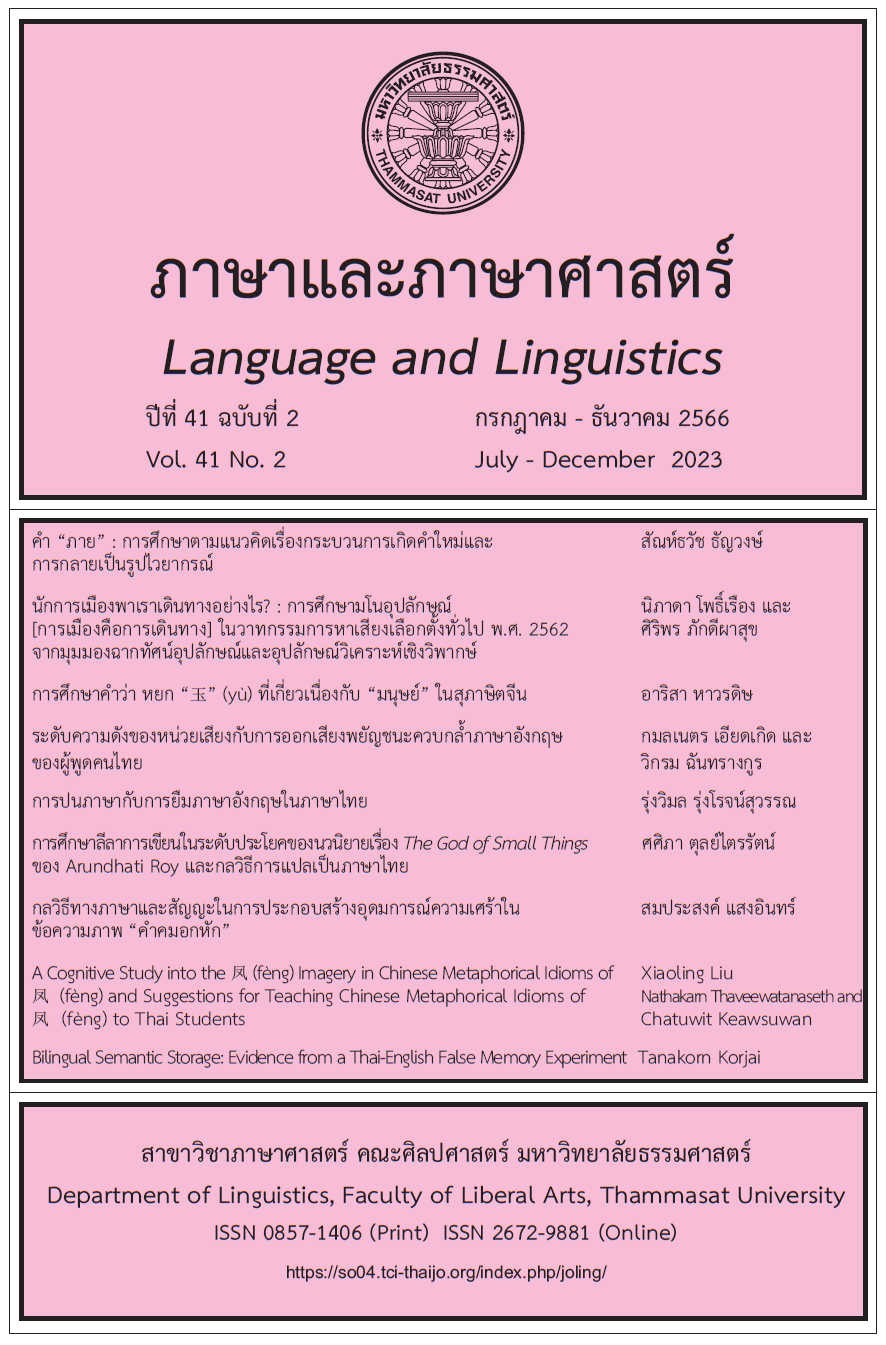The Research on Chinese proverbs with Jade “玉” (yù) in the concept of “humans”
Main Article Content
Abstract
This research article aims to study the word “玉” (yù) within the framework of a study of words related to humans in Chinese proverbs. After the accumulation, collection and analysis, the researcher found that there are 62 proverbs composed of four characters that appear with “jade” words. They consist of jade “玉” (yù) which relates to human appearance and skin; jade “玉” (yù) which relates to human character, actions, way of life; jade “玉” (yù) which relates to human goodness; jade “玉” (yù) which relates to human abilities; jade “玉” (yù) which relates to the use of human language; jade “玉” (yù) which relates to human construction; jade “玉” (yù) which relates to human property, human supplies; jade “玉” (yù) which relates to seasons, nature; jade “玉” (yù) which relates to human ancestry; jade “玉” (yù) which relates to food; and jade “玉” (yù) which relates to life expectancy in Chinese proverbs, which are all related to “humans”.
The results show that jade has not only played an important role in the discourse of Chinese people since ancient times, but also has an important significance in many aspects such as lifestyle, society, philosophy, beliefs, art, archeology, and history.
Article Details

This work is licensed under a Creative Commons Attribution-NonCommercial-NoDerivatives 4.0 International License.
บทความทุกบทความเป็นลิขสิทธิ์ของภาษาและภาษาศาสตร์
References
กนกพร นุ่มทอง และ ศิริวรรณ ลิขิตเจริญธรรม. (2562). หลักและข้อควรระวังในการแปลจีน-ไทย ไทย-จีน. วารสารจีนศึกษา มหาวิทยาลัยเกษตรศาสตร์, 12(2), 136-137.
นววรรณ พันธุเมธา. (2563). คลังคำ (พิมพ์ครั้งที่ 9). อมรินทร์ พริ้นติ้ง แอนด์ พับลิชชิ่ง.
เผย์ เสี่ยวรุ่ย. (2546). พจนานุกรมจีน-ไทย. สำนักพิมพ์ทฤษฎี.
อาริสา หาวรดิษ. (2564). ลักษณะสุภาษิตที่ปรากฏคำว่า “เรียน” ในสุภาษิตจีน. วารสารจีนศึกษา มหาวิทยาลัยเกษตรศาสตร์, 14(1), 23-42.
อาริสา หาวรดิษ. (2565). การศึกษาคำว่า “气” (qì) ที่ปรากฏร่วมกับ “อวัยวะ” ในคำพังเพยจีน. วารสารภาษาและภาษาศาสตร์ มหาวิทยาลัยธรรมศาสตร์, 40(1), 172.
เอนก หุตังคบดี และ ราช รามัญ. (2550). หยก อัญมณีจากสวรรค์และความเชื่อ. เพชรประกาย.
CASS Institute of Linguistics Dictionary中国社会科学院语言研究所词典编辑室. (2018). 现代汉语大词典 (第7版). 商务印书馆.
Chengyudacidian bianweihui 《成语大词典》编委会. (2019). 成语大词典 (第2版). 商务印书馆国际有限公司.
Forsyth, A., & McElney, B. (1994). The museum of east Asian art: Jades from China. Hong Kong Prime Printing.
Gu Fang古方. (2006). 红粉帝国的幽梦: 图说殷墟妇好墓. 重庆出版社.
He Kezhou & Fan Xiaohui何克州, 范小慧. (2019). 东方宠贝: 喇家卷. 陕西科学技术出版社.
Liu Liangyou刘良佑. (1993),古玉新鑑 (第3版). 尚亚美术出版.
Ma Yijin 马一金. (1999). 辞海 (第6版,第3卷). 上海辞书出版社.
Nott, S. C. (1962). Chinese jade throughout the ages. (2nd ed.). The Charles E. Tuttle.
Shangwuyinshuguancishuyanjiuzhongxin商务印书馆辞书研究中心. (2015). 新华成语词典 (第2 版). 商务印书馆.
Wu, H. (1985). Bird motifs in eastern Yi art. Orientations.
Yin Weizhang殷玮璋. (2000). 百年考古之谜. 中国经济出版社.
Yu, M. (2009). Chinese jade. China Intercontinental Press.
Zhongguodabaikequanshu《中国大百科全书》总编辑委员会. (1990). 中国大百科全书. 中国大百科全书出版社.


